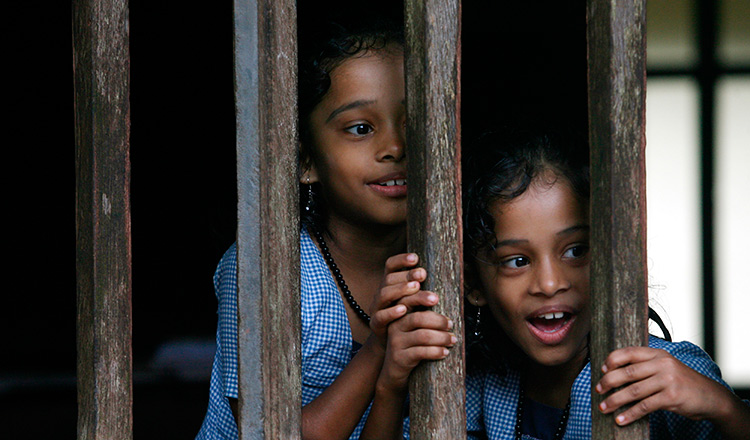MED TECH: India – Scientists puzzled by twin births boom in Indian village
.
.
The medical fraternity is trying to unravel the unusual rate of twin births in Kodinhi, a tiny village in southern Kerala state where some 2,000 families have over 450 pairs of twins. DW’s Murali Krishnan reports.
A blue sign board on the highway reads, “Welcome to the God’s own Twins Village – Kodinhi.” It is the twins’ phenomenon or explosion here that has catapulted the village to global fame even as baffled doctors and scientists try to find a plausible explanation.
This commonplace yet bustling village – located in the Malappuram district, some 150 kilometers from the coastal city of Kochi – has the distinction of having the highest number of twins per capita in the world.
Twins here account for 42 of every 1,000 births, almost six times as high as the global average of around six per 1,000 births.
At the Madrasathul Anwar Higher Secondary School, Sumayat and Afsayat, twins aged 16, have finished school and head home along with their classmates. Both are identical twins and they say teachers still have a tough time distinguishing them.
“On most occasions, they call out both our names to identify who is who. We have had some humorous incidents, both at school and outside, but we don’t find it a problem,” said Ms Sumayat.
Their principal, Najeeb (who goes by only one name), is acutely aware of the high occurrence of twins in Kodinhi and watches the pattern with much curiosity.
“There are 17 pairs of twins in the school and we are happy about it. Occasionally, we have had problems identifying them and there is the potential for mischief. But that is not a huge issue,” the principal said.
Mr Arshad and Ms Asif, another matching pair, are passionate footballers. During a match, the organisers try to ensure that they are on the same side lest it creates confusion in the opposite team.
“Even then, there is uncertainty as both of us play midfield and the opponents don’t know who to mark at times,” Mr Asif says jokingly.
Although 85 percent of the village’s population is Muslim, the twinning phenomenon extends to the Hindu minority as well. According to doctors and locals in the community, the medical marvel started almost 60 to 70 years ago.
“The oldest pair of female twins is 70 years old and all I can say is that this occurrence is God sent. Many women who came to Kodinhi after marrying someone here have also experienced twin births,” Mr Mustafa Shaikh, the local village council chief, told DW.
The oldest pair of surviving twins is Kunhi Pathuty and Pathuty, sisters who believe the happening is unique to the village. “This is God’s blessing. That is all. Science can prove nothing. We are now witnessing triplets and quadruplets being born. Don’t seek too many answers,” Ms Pathuty told DW.
Following the rapid rise in twins, a joint team comprising researchers from various institutions in India, Germany and the UK arrived two years ago to collect saliva samples from the twins in a bid to isolate their DNA and try to find out the reasons for the boom.
Another team carried out research on the anthropometric measures (height and weight), photographic analysis (facial and lateral profile forms) and occlusal characteristics (dentition status and occlusal characteristics) among the twins.
So far, the data collected from the many twins is still being subjected to deeper analyses with no concrete conclusion arrived at.
“Nothing has been proved scientifically. Some say it is genetic but there is no proof. Some more tests will need to be conducted if we have to say anything concrete,” E Preetham, a scientist from Kerala, told DW.
Other doctors like Sribiju, a public health practitioner who has been studying the issue closely, believe there is some chemical, or component in the air, earth or water that is stimulating the female ovary to produce dizygotic eggs.
In 2008, he conducted a survey which recorded 264 pairs of twins in the village, and the number now has reached over 450 pairs. But the count is never accurate, he reckons.
“Unlike in the West and other locations where twinning is also rife, in Kodinhi the situation is different. There are no artificial methods used, no IVF or contraceptive pills and women do not resort to clomiphene citrate oral medication to promote ovulation,” Mr Sribjiu told DW.
He also pointed out that the women who gave birth to twins conceived normally, were relatively young and had them in their first pregnancy.
“We think more will be revealed through a detailed genetic and environment study, and the task now is to find out what the stimulator is. It needs extensive research, from scratch,” added Mr Sribiju.
A similar kind of twin-birth phenomenon has also been reported in two other villages – Igbo ora, in Nigeria, and Cândido Godói, in Brazil – with researchers establishing the reason behind it as genetic.
In the former, it was discovered that a chemical found inside the women and the peelings of a widely consumed yams might be the cause of multiple twin births.
In Cândido Godói, a municipality situated in northern Brazil and home to a population of 6,500, researchers said the rate of twinning could be ascribed to the fact that it is a closed community with high incidence of inbreeding.
Kodinhi’s Twins and Kins Association (TAKA), the only society of its kind in India, came up in 2006 when the pattern of increasing number of twins began to swell.
Puallani Bhaskaran, the association’s president, who also has twin children, says TAKA is now trying to provide financial support and other forms of assistance for families who are relatively poor.
“We had to do something for the welfare of the twins when we discovered this incredible trend. Sometimes we give medical help to families by paying off bills. This is the least we can do.”
The village may have become a media spectacle but there is a strong bond that binds the people of Kodinhi in this peculiar village of twins.
This feature first appeared at http://www.dw.com / Murali Krishnan / DW









